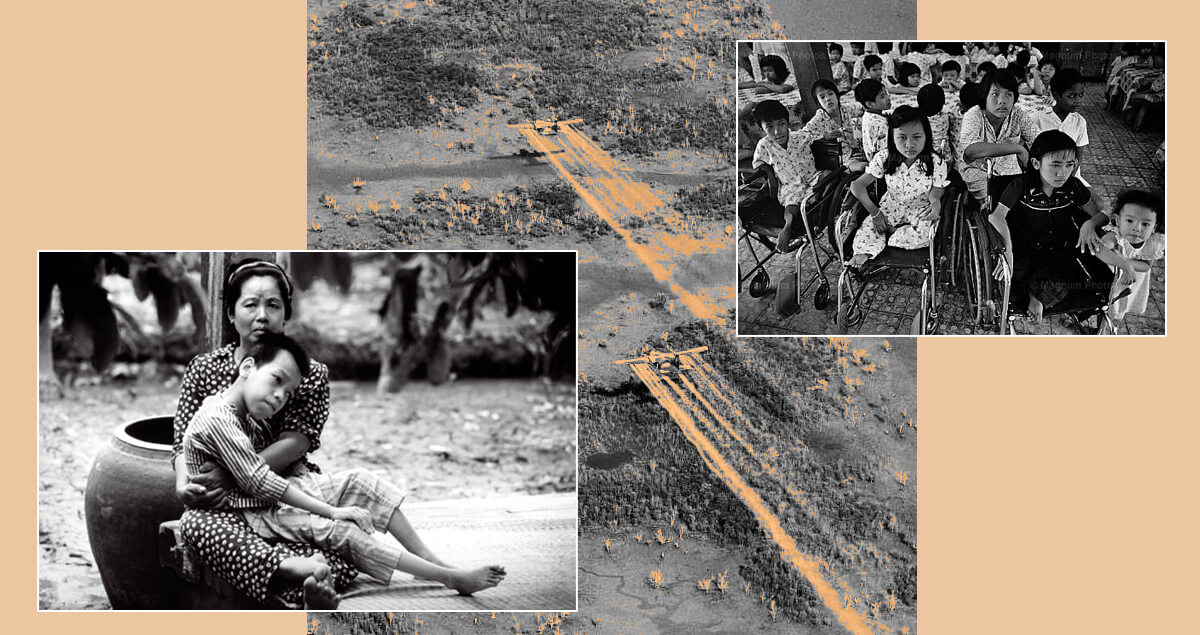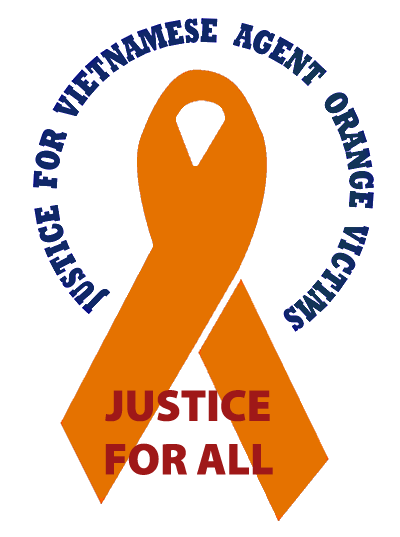Introduction to Agent Orange and Our Campaign

The Vietnam Agent Orange Relief and Responsibility Campaign is an initiative of U.S. veterans, Vietnamese Americans and all concerned about peace and justice. Vietnamese citizens are taking action to assist the victims and to hold responsible those whose use of chemical weapons constitutes crimes against humanity. Now it’s our turn to act: With this campaign, we seek to fulfill our responsibility by insisting that our government honor its moral and legal responsibility to compensate the Vietnamese victims of Agent Orange.

BACKGROUND
In 1961, as part of America’s escalating war of counter-insurgency in Vietnam, President Kennedy approved military plans to use toxic herbicides in Vietnam. Planes and helicopters from the U.S. military, under the code name “Operation Ranch Hand,” sprayed toxic chemicals throughout southern Vietnam. The spraying was intended to kill foliage to deny cover to the guerillas and to destroy crops that could be used to supply the insurgency. The spraying was also intended to make whole areas unlivable so that villagers would be driven into “pacified” areas and “strategic hamlets.”
The main victims were civilians in the villages who were repeatedly contaminated when they ate crops and drank ground water that had been sprayed.
The most commonly used spray was dubbed “Agent Orange” because it was shipped in barrels with an Orange stripe.
The 2,4,5-T herbicide is contaminated with trace amounts of TCDD dioxin, the most toxic chemical known to science. Lab animals exposed to minute quantities of dioxin (in parts per billion) have suffered increased rates of birth defects. The FDA withdrew approval for the use of 2,4,5-T in the United States in 1970. Dioxin has a half-life of about 10 years (i.e., after 10 years 50% of dioxin is still present in the soil).
The chemicals used during the Vietnam War were produced by Dow, Monsanto, Diamond Shamrock, Hercules, Uniroyal, Thomson Chemicals, etc. In March 1965, Dow Chemical called all the manufacturers to a secret meeting at Dow Headquarters in Midland, MI. Dow’s scientists complained that producers were making very “dirty” 2,4,5-T, containing as much as 50 parts per million of TCDD dioxin. They warned that if the offenders didn’t “clean up their act” by improving product quality, it could eventually bring the entire herbicide program down. The chemical companies ignored this warning and kept the deadly dioxin in Agent Orange.
WHAT DID THE US MILITARY KNOW?
Dr. James R. Clary, a former senior scientist at the Chemical Weapons Branch (Air Force Armament Development Lab in Florida) writes:
“When we initiated the herbicide program in the 1960s, we were aware of the potential for damage due to dioxin contamination in the herbicide. We were even aware that the military formulation had a higher dioxin concentration than the civilian version due to the lower cost and speed of manufacture. However, because the material was to be used on the enemy, none of us were overly concerned.”
This statement illustrates the racism underlying the continuing use of Agent Orange against the Vietnamese people and the failure to compensate them.
EFFECTS ON PEOPLE’S HEALTH
An estimated 50,000 deformed children have been born to parents who were directly sprayed or were exposed through the consumption of food and/or water.
The risk of death from cancer among men and women exposed to dioxin increased by 30%.
Parents exposed to Agent Orange were 2.2 times more likely to have a deformed child than nonexposed parents.
The Veterans Administration now automatically awards service-connected disability to Vietnam veterans for fifteen different health conditions. Conditions include soft tissue cancer, Non Hodgkin’s lymphoma, Hodgkins Disease, chronic lymphocytic leukemia, cancer of the prostate, larynx, and trachea, multiple myeloma, acute and subacute transient peripheral neuorpathy, Type II diabetes, spina bifida, chloracne, B-cell leukemia, Parkinson’s disease and ischemic heart disease.
Exposure to Agent Orange/dioxin is also associated with disorders of the endocrine system (e.g., decreased sexual desire, gynecomastia), cardio-vascular system (e.g. increased blood pressure, blood deficiency), gastrointestinal system (e.g., nausea, vomiting, diarrhea, gastric ulcer, constipation, yellowing of eyes, abdominal pain), metabolic system (e.g. fatigue, rapid weight loss, spontaneous fever, chills), neurological system (e.g. numbness, dizziness, headaches, tingling), respiratory system (e.g. shortness of breath), and skin disorders (such as rash, loss of hair, brittle nails, altered skin color).
Dioxin from Agent Orange still contaminates the soil and natural environment in many “hot spots” in central and south Vietnam such as Da Nang, Bien Hoa, and A Luoi Valley.
MAGNITUDE OF THE PROBLEM
After visiting Vietnam in 1969, two U.S. zoologists wrote: “The chemical weapons of a technologically advanced society are being used massively for the first time in a guerilla war… (Our) military efforts are aimed at increasing the toll of fatalities, denying food to the enemy, and depriving him of the concealment provided by natural growth. This type of warfare is, therefore, enormously destructive, both of human life and the environment.”
Between 1962 and 1971 the United States sprayed an estimated twenty million gallons of herbicide (of which thirteen million gallons were Agent Orange) over a tenth of the total land area of southern Vietnam. The Agent
Orange used is estimated to have contained over 500 pounds of TCDD dioxin!
Over 5.6 million acres of southern Vietnam were eventually sprayed, with over 90% of the sprayed areas being hit at least twice. An estimated 11% of the areas were hit as many as ten times. Further, records show that the Air Force used 2,4,5-T herbicide in concentrations that were as much as thirteen times higher than that recommended by the manufacturers for domestic use in the U.S. Vietnamese scientists have estimated that as many as 4.8 million Vietnamese citizens were directly exposed to these herbicides.
IS IT A WAR CRIME?
The chemical campaign mounted by the US military is arguably in violation of the following international treaties:
The 1907 Hague Convention (IV) which prohibits the use of poison or poisoned weapons or the use of materials calculated to cause unnecessary suffering.
The Geneva Protocol of 1925 which bans the use of asphyxiating, poisonous or other gases, usually referred to as chemical weapons.
The Rome Statute for the International Criminal Court which prohibits the use of “weapons … or methods of warfare which are of a nature to cause superfluous injury or unnecessary suffering.”
In 1975, President Gerald Ford signed an Executive Order, which renounced “first use” of herbicides in warfare. At almost the same time, the U.S. Senate formally ratified the 1925 Geneva Protocol, which banned chemical weapons.
THE PRESENT SITUATION: WHY IS THIS IMPORTANT NOW?
In 1973, the U.S. government signed the Paris Peace Accords with Vietnam. One article contains an explicit American promise to help heal the wounds of war in Vietnam. The U.S. initially committed $3.25 billion to be provided over a five year period. It later promised to provide an additional $1.5 billion in other forms of aid. None of these commitments have ever been honored.
A federal class action lawsuit filed on behalf of U.S. Vietnam veterans against the chemical manufacturers was settled in 1984 for $180 million. Unfortunately since there were ten times more claims against this fund than had been predicted, veterans received only token amounts of compensation.
In 1991, following years of organizing and lobbying by Vietnam veterans, Congress ordered the Veterans Administration to provide disability benefits to Vietnam veterans who suffered from certain illnesses determined to be causally linked to Agent Orange exposure by a federal scientific panel.
A 2004 lawsuit filed by Vietnamese victims of Agent Orange against the herbicide manufacturers Dow, Monsanto and 35 others was dismissed but has raised international public awareness and support including a judgment by the International Peoples’ Tribunal of Conscience in Support of the Vietnamese Victims of Agent Orange.
International public opinion and new scientific studies correlating Agent Orange and illnesses have caused New Zealand and England to compensate their Agent Orange victims and Australia to offer compensation. Dioxin affected Vietnam Veterans in South Korea have won a lawsuit against Dow and Monsanto, and Canadians are fighting for compensation for citizens injured during testing of Agent Orange.
Since Vietnam, the American military has continued to use toxic weapons. For example, the Pentagon is making heavy use of radioactive “depleted uranium” shells, napalm and phosphorus bombs in its wars in Iraq and Afghanistan. To date, it has refused to acknowledge that these weapons present a health hazard to either civilians or soldiers.
The U.S. congress has allocated $6 million to clean up one hot spot and provide medical care to victims in Danang but the money has yet to reach the victims.
To date, not a single Vietnamese victim of Agent Orange has ever received a penny in compensation for the injuries they have suffered.
JOIN US TO:
Organize to achieve justice for Vietnamese Agent Orange victims
- Contact your congress members and tell them you want our government to meet its responsibility to provide aid and treatment to Vietnam’s Agent Orange victims, to the children of U.S. veterans and for affected Vietnamese-Americans! Sign the orange postcard to Congress and return it to our Campaign!
- Pass a resolution in your community group, school, place of worship, veteran’s organization or union asking Congress to allocate funds to care for and compensate Vietnam’s Agent Orange victims and clean up the toxic “hot spots.”
- Tell Dow Chemical, Monsanto and the other corporations who profited from manufacturing Agent Orange to compensate their victims, by joining our corporate campaign. Please contact us about protests at Dow and Monsanto events.
Educate our friends, co-workers and neighbors about the suffering caused by Agent Orange in Vietnam and in other wars our government has waged
Organize an event at your home, school, community center or place of worship. Contact us for films and educational materials. We will continue to bring Vietnamese Agent Orange victims to tour communities throughout the nation with disabled U.S. veterans. These visits will also build solidarity with U.S. communities fighting against toxic contamination and environmental racism. Contact us if you would like to host a visit by a group to your area.

Donate to Vietnamese Agent Orange victims
Funds will go to the Vietnam Association for Victims of Agent Orange/Dioxin (VAVA) and to educational work within the U.S. to achieve the goals of this campaign. Tax deductible contributions may be made to Veterans For Peace/VAORRC and sent to VAORRC, P.O. Box 303, Prince Station, New York, NY 10012-0006, or online.
Achieving real justice for Vietnamese Agent Orange victims will be an important step toward our government’s taking full responsibility for the longterm devastation that its chemical weaponry caused the Vietnamese people and all Vietnam war veterans. This tragic chapter in our nation’s history will not be satisfactorily closed until WE THE PEOPLE of the United States compel our government to do the right thing. Thirty years late is better than never!
Thank you for your participation and support. Together, we can make The Vietnam Agent Orange Relief and Responsibility Campaign a resounding success!
Our brochure is designed to be printed on 11″x17″ paper, folded in half horizontally, and then tri-folded vertically.
